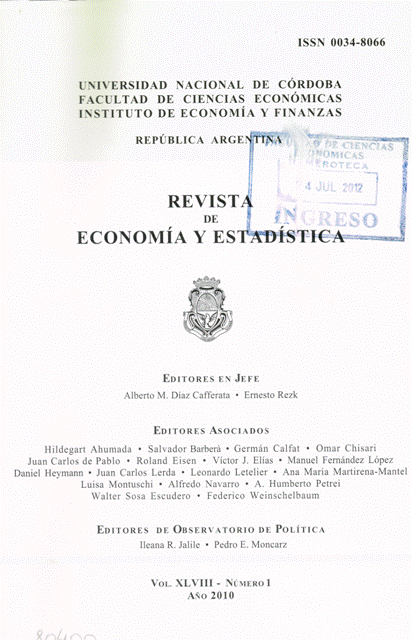The Crisis, Automatic Stabilisation, and the Stability Pact
DOI:
https://doi.org/10.55444/2451.7321.2010.v48.n1.3871Keywords:
automatic stabilisers, tax progressivity, unemployment benefits, discretionary fiscal policy, European fiscal institutions , Stability and Growth PactAbstract
This paper develops a comprehensive description of recent trends on the effectiveness of automatic stabilisers in the European Union, using both macro evidence on the cyclical sensitivity of budget deficits to economic activity and micro evidence on the tax and expenditure profi les. We conclude that there is increasing evidence of the declining importance of the automatic stabilisation. This points to a fundamental contradiction in the European Stability and Growth Pact, that relies almost exclusively on automatic stabilisation for the conduct of fi scal policy, We also argue, on the basis of past experience, that further increasing market fl exibility does not seem a viable path to reduce aggregate fluctuations. The paper concludes by highlighting the complex relation between discretionary policies and automatic stabilisation.
Downloads
References
Afonso A. and D. Furceri (2008), “EMU enlargement, stabilisation costs and insurance mechanisms”, Journal of International Money and Finance, 27(2), 169-187.
Arestis, P., McCauley, K. and Sawyer, M., (2001) “An alternative stability pact for the European Union”, Cambridge Journal of Economics, 25(1), 113-130.
Arestis, P. and M. Sawyer (2003), “Reinventing fiscal policy”, Journal of Post-Keynesian Economics, 26(1), 3-25.
Arestis, P. and M. Sawyer (2010), “The return of fiscal policy”, Journal of Post-Keynesian Economics, 32(3), 327-346.
Barrell R. and A.M. Pina (2004), “How Important Are Automatic Stabilisers in Europe? A Stochastic Simulation Assessment”, Economic Modelling, 21(1), 1-35.
Barro R.J. (1974), “Are Government Bonds Net Wealth?”, Journal of Political Economy, 82(6), 1095-117
Bertola G., Boeri T. and Cazes S. (2000), “Employment protection in industrialized countries: The ca se for new indicators”, International Labour Review, 139(1).
Blanchard, O. and R. Perotti (2002). “An Empirical Characterization of the Dynamic Effects of Changes in Government Spending and Taxes on Output.” Quarterly Journal of Economics 117(4), 1329-68.
Blinder, A. S. (2006). "The Case against the Case against Discretionary Fiscal Policy". The Macroeconomics of Fiscal Policy. R. W. Kopcke, G. M. B. Tootell et R. K. Triest, Eds. Cambridge and London, MIT Press, 25-61.
Blix M. (2008), “How well do the automatic stabilisers work?”, mimeo.
Brunila, A., M. Buti and J. In't Veld (2002). “Fiscal Policy in Europe: How Effective Are automatic Stabilisers?” European Economy, Economic Papers, 1 no. 77-2002.
Buti M., S.C.W. Eijffinger and D. Franco (2003), “Revisiting the SGP: Grand Design or Internal Adjustment?”, CEPR Discussion Paper, no.3692, January.
Candelon B., J. Muysken and R. Vermeulen (2010), “Fiscal policy and monetary integration in Europe: an update”, Oxford Economic Papers, 62(2), 323-349.
Creel J. and F. Saraceno (2009), “Automatic stabilisation, discretionary policy and the Stability Pact”, in J. Creel and M. Sawyer (eds.), Current thinking on fiscal policy, Basingstoke: Palgrave MacMillan, January.
Crespo Cuaresma J., G. Reitschuler, and M.-A. Silgoner (2009), “On the effectiveness and limits of fiscal stabilizers”, Applied Economics, August, 1-8.
Darby, J. and J. Melitz (2008). "Social Spending and Automatic Stabilizers in the OECD." Economic Policy 56: 715-46
Debrun X., J. Pisani-Ferry and A. Sapir (2008), “Government size and output volatility: should we forsake automatic stabilization?”, European Economy, Economic Papers 316, April.
de Grauwe, P. (2003). “The Stability and Growth Pact in Need of Reform”, mimeo, University of Leuven.
European Commission (2001), “Public finances in EMU – 2001”, European Economy, 3.
Farina F. and R. Tamborini (eds.) (2007), Economic Policy in the EMU. From the Old to the New Stability and Growth Pact, London: Routledge.
Farina F. and R. Ricciuti (2006), “L’évaluation des politiques budgétaires en Europe”, Revue de l’OFCE, 99, Pp. 275-301
Fatas A. and I. Mihov (2001), “Government size and automatic stabilisers: international and intranational evidence”, Journal of International Economics, 56(1), 3-28.
Fitoussi, J.-P. (2003), "The Beveridge Curve, Unemployment and Wages in the OECD from the 1960s to the 1990s: Comment", in P. Aghion et al, (Eds.), Knowledge, information, and expectations in modern macroeconomics: In honor of Edmund S. Phelps, 432-40, Princeton and Oxford, Princeton University Press.
Fitoussi J.-P. and J. Le Cacheux (eds.) (2007), Report on the State of the European Union Volume 2. Basingstoke: Palgrave-MacMillan.
Gali J. (1994), “Government Size and Macroeconomic Stability,” European Economic Review, vol. 38, 117-132.
Gali, J. and R. Perotti (2003). “Fiscal Policy and Monetary Integration in Europe.” Economic Policy 0(37), pp. 533-64.
Giorno C., P. Richardson, D. Roseveare and P. van den Noord (1995), "Estimating Potential Output, Output Gaps and Structural Budget Balances," OECD Economics Department Working Papers 152, OECD, Economics Department.
Girouard N. and C. André (2005), “Measuring cyclically-adjusted budget balances for OECD countries”, OECD Economics Department Working Paper 434.
Iacobucci, A. and A. Noullez (2005). "A Frequency Selective Filter for Short-Length Time Series." Computational Economics, 25 (1-2), 75-102.
IMF (2007) World Economic Outlook: Globalization and Inequality. October.
Krueger, D., F. Perri, L. Pistaferri and G. Violante (2010), “Cross Sectional Facts for Macroeconomists”, Review of Economic Dynamics - Special Issue, 13(1).
Lee Y. and T. Sung (2007), “Fiscal policy, business cycles and economic stabilisation: evidence from industrialised and developing countries”, Fiscal Studies, 28(4), 437-462.
McConnell M.M. and G. Perez-Quiros (2000), “Output Fluctuations in the US: What Has Changed Since the Early 1980’s?”, American Economic Review, 90(5), 1464-76.
Nicoletti, G., S. Scarpetta and O. Boylaud (2000), “Summary Indicators of Product Market Regulation with an Extension to Employment Protection Legislation” OECD Economics Department Working Papers , 226, April.
OECD (2006), Employment outlook, Paris: OECD.
OECD (2008), Growing Unequal? Income Distribution and Poverty in OECD Countries. October.
Ploberger W. and W. Krämer (1992), “The CUSUM test with OLS residuals”, Econometrica, 60(2), 271-85.
Saint-Etienne C. and J. Le Cacheux (2005), “Croissance équitable et concurrence fiscale”, Rapport du Conseil d'analyse économique, 56, La Documentation française, October.
Sapir A., P. Aghion, G. Bertola, M. Hellwig, J. Pisani-Ferry, D. Rosati, J. Vinals and H. Wallace (2004), An Agenda for a Growing Europe, Oxford University Press.
Scharnagl M. and K-H. Tödter (2004), “How effective are automatic stabilisers? Theory and empirical results for Germany and other OECD countries”, Deutsche Bundesbank Discussion Paper, 21.
Sterdyniak H. (2005), “Taxation in Europe: Towards more competition or more co-ordination”, OFCE Working Paper, 19-2005.
Van den Noord P. (2000), “The size and role of automatic stabilisers in the 1990s and beyond”, OECD Economics Dpt. Working Paper, 230.
Downloads
Published
How to Cite
Issue
Section
License
Copyright (c) 2010 Jérome Creel, Francesco Saraceno

This work is licensed under a Creative Commons Attribution-NonCommercial-NoDerivatives 4.0 International License.
Authors who have publications with this journal agree to the following terms:
Authors retain their copyright and grant the journal the right of first publication of their work, which is simultaneously subject to the Creative Commons Attribution-NonCommercial-NoDerivatives 4.0 International License that allows third parties to share the work provided that its author and first publication in this journal are indicated.
Authors may adopt other non-exclusive licensing arrangements for distribution of the published version of the work (e.g. depositing it in an institutional telematic archive or publishing it in a monographic volume) as long as the initial publication in this journal is indicated.
Authors are allowed and encouraged to disseminate their work via the Internet (e.g. in institutional telematic archives or on their website) before and during the submission process, which can lead to interesting exchanges and increase citations of the published work. (See The Open Access Effect)









